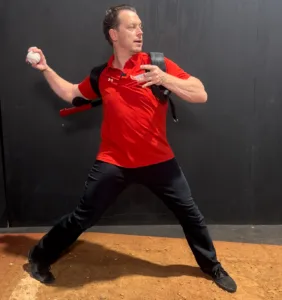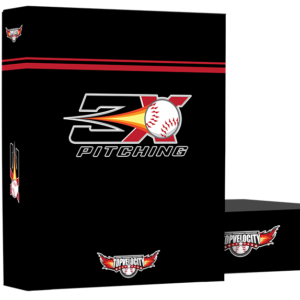Aspiring pitchers often wonder, "How fast should you be pitching by age?" This question is crucial for both young athletes looking to gauge their progress and coaches seeking to develop their players effectively. In this comprehensive guide, we'll explore the optimal pitching speeds for various age groups, training techniques to enhance velocity, injury prevention strategies, and answer frequently asked questions about pitching speed.
Average Pitching Velocity by Age: How fast should you be pitching by age?
| Age | Average Pitch Speed |
|---|---|
| 9-10 | 40-50 mph |
| 11-12 | 50-60 mph |
| 13-14 | 60-75 mph |
| 15-16 | 70-80 mph |
| 17-18 | 75-85 mph |
 Understanding Pitching Speed: How fast should you be pitching by age?
Understanding Pitching Speed: How fast should you be pitching by age?
- Definition of pitching speed: Pitching speed refers to the velocity at which a baseball is thrown by a pitcher. It is measured in miles per hour (mph) and serves as a critical indicator of a pitcher's effectiveness on the mound.
- Importance of pitching speed: Pitching speed directly impacts a pitcher's ability to overpower hitters, resulting in more strikeouts and fewer hits allowed. Additionally, higher velocity pitches create deception, making it challenging for batters to time their swings effectively.
Factors Affecting Pitching Speed: How fast should you be pitching by age?
- Physical factors: Muscular strength, flexibility, and explosiveness significantly influence pitching speed. Additionally, biomechanics, including arm action and stride length, play a crucial role in maximizing velocity.
- Technical factors: Proper pitching mechanics, such as hip and shoulder rotation, arm angle, and release point, are essential for generating maximum velocity while minimizing stress on the arm.
- Mental factors: Confidence, focus, and mindset can impact a pitcher's ability to reach their optimal velocity. Mental toughness is crucial for maintaining consistency and composure on the mound.
 How Pitching Speed is Measured: How fast should you be pitching by age?
How Pitching Speed is Measured: How fast should you be pitching by age?
Pitching speed is typically measured using radar guns or advanced tracking systems, such as PitchTracker. These technologies provide accurate velocity readings and valuable data for coaches and players to analyze and adjust their training programs accordingly.
Optimal Pitching Speed by Age: How fast should you be pitching by age?
- Pitching speed benchmarks for different age groups: While there is no universal standard for pitching velocity by age, certain benchmarks can serve as general guidelines. For example, elite high school pitchers may throw in the range of 85-95 mph, while college and professional pitchers often exceed 90 mph or more.
- Developmental considerations: It's essential to consider the physical and emotional development of young pitchers when assessing their pitching speed. Pushing athletes beyond their capabilities can lead to injuries and burnout, so a gradual approach to velocity development is recommended.
 Training Techniques to Improve Pitching Speed
Training Techniques to Improve Pitching Speed
- Strength and conditioning exercises: A comprehensive strength training program targeting the lower body, core, and shoulder muscles can enhance explosiveness and velocity. Exercises such as squats, deadlifts, and medicine ball throws are beneficial for developing pitching power.
- Pitching mechanics adjustments: Working with a knowledgeable pitching coach to refine mechanics can unlock hidden velocity potential. Focus on optimizing stride length, arm action, and timing to maximize energy transfer from the lower body to the arm.
- Mental training strategies: Visualization, goal setting, and positive self-talk can help pitchers harness their mental game and perform at their peak. Developing mental toughness and resilience is essential for overcoming adversity and thriving under pressure.
Injury Prevention Strategies
- Importance of injury prevention: Pitchers are susceptible to various arm injuries, including rotator cuff tears, elbow ligament sprains, and shoulder impingement. Prioritizing injury prevention strategies is critical for long-term health and performance.
- Common pitching-related injuries: Overuse, poor mechanics, and insufficient rest can contribute to injuries in pitchers of all ages. It's crucial to address any signs of discomfort or fatigue promptly and incorporate rest and recovery into training regimens.
- Prehabilitation exercises: Incorporating prehabilitation exercises, such as shoulder stabilization drills, rotator cuff strengthening, and dynamic stretching routines, can help prevent injuries and improve overall durability.
TopVelocity Training Programs: Enhancing Velocity and Preventing Injury
TopVelocity offers cutting-edge training programs, such as the 3X Pitching Velocity Program, designed to optimize pitching performance and reduce the risk of injury. In addition to these programs, tools like the Stride Excelerator and the Trunk Excelerator play a crucial role in enhancing velocity while promoting proper mechanics and injury prevention.
 3X Pitching Velocity Program
3X Pitching Velocity Program
The 3X Pitching Velocity Program, developed by Brent Pourciau, leverages scientific principles and biomechanical analysis to maximize pitching velocity. This comprehensive program focuses on improving strength, power, flexibility, and pitching mechanics through a combination of drills, exercises, and personalized coaching.
By incorporating elements of Olympic weightlifting, plyometrics, and functional movement patterns, the 3X Pitching Velocity Program targets key muscle groups involved in the pitching motion. Through progressive overload and periodization, athletes can develop explosive power and velocity while minimizing the risk of overuse injuries.
 Stride Excelerator
Stride Excelerator
The Stride Excelerator is a revolutionary training tool designed to optimize stride length and timing, essential components of an efficient pitching delivery. By promoting proper hip rotation and forward momentum, this device helps pitchers generate maximum power and velocity while reducing stress on the arm and shoulder.
Utilizing the Stride Excelerator in conjunction with the 3X Pitching Velocity Program allows athletes to fine-tune their mechanics and achieve optimal stride length and direction. By consistently practicing with this tool, pitchers can develop muscle memory and improve their overall pitching performance while mitigating the risk of mechanical flaws and injuries.
 Trunk Excelerator
Trunk Excelerator
The Trunk Excelerator focuses on strengthening the core muscles responsible for stabilizing the torso during the pitching motion. By improving trunk rotation, stability, and deceleration, this training tool enhances energy transfer from the lower body to the arm, resulting in increased velocity and pitching efficiency.
Incorporating the Trunk Excelerator into the training regimen helps pitchers maintain proper posture and alignment throughout the pitching delivery. By strengthening the core muscles and promoting proper sequencing, athletes can minimize the risk of injury to the lower back, obliques, and abdominal muscles, ensuring long-term durability and performance on the mound.
Velocity Enhancement and Injury Prevention
TopVelocity's holistic approach to pitching development emphasizes the importance of both velocity enhancement and injury prevention. By integrating innovative training programs and state-of-the-art tools like the 3X Pitching Velocity Program, Stride Excelerator, and Trunk Excelerator, athletes can optimize their performance while minimizing the risk of overuse injuries and mechanical breakdowns.
Through targeted strength and conditioning exercises, biomechanical analysis, and mental training strategies, TopVelocity empowers pitchers to reach their full potential while maintaining long-term health and durability. Whether aspiring to play at the collegiate or professional level, athletes can benefit from TopVelocity's evidence-based approach to pitching development, ensuring a sustainable and successful career on the diamond.
FAQs:
What is the average pitching speed for a teenager?
The average pitching speed for a teenager can vary depending on factors such as age, experience, and physical development. Generally, high school pitchers may throw anywhere from 70 to 85 miles per hour (mph), with elite athletes reaching velocities upwards of 90 mph or more. It's essential to remember that pitching speed is not the sole indicator of talent or potential, as factors like command, movement, and off-speed pitches also play significant roles in a pitcher's effectiveness on the mound.
Can pitching speed be improved at any age?
Yes, pitching speed can be improved at any age through proper training, technique refinement, and physical conditioning. While younger athletes may experience more significant gains due to their rapid growth and development, pitchers of all ages can enhance their velocity with dedicated practice and structured training programs. By focusing on strength and conditioning exercises, biomechanical adjustments, and mental preparation, pitchers can unlock their full potential and achieve higher velocities regardless of their age or experience level.
How does pitching speed change with age?
Pitching speed tends to increase during adolescence as athletes mature physically and refine their mechanics. However, the rate of velocity improvement may plateau in the late teens or early twenties as players reach peak physical condition. Factors such as genetics, training regimen, and injury history can also influence how pitching speed changes over time. While some pitchers may experience gradual declines in velocity as they age, others may maintain or even improve their speed through proper maintenance and adjustment of their training programs.
Are there risks associated with pitching too fast?
While pitching velocity is often celebrated as a sign of elite talent, excessive emphasis on speed can pose risks to a pitcher's long-term health and performance. Pitching too fast without proper mechanics or conditioning can increase the likelihood of arm injuries, including ligament tears, muscle strains, and stress fractures. Additionally, pitchers who consistently throw at maximum effort may experience fatigue, decreased accuracy, and diminished pitch quality over time. Therefore, it's crucial for athletes to prioritize balanced development and injury prevention strategies to avoid the detrimental effects of overexertion.
What role does genetics play in pitching speed?
Genetics can influence various aspects of pitching performance, including muscle fiber composition, joint structure, and biomechanical efficiency. Athletes with a genetic predisposition for fast-twitch muscle fibers and optimal limb proportions may have a natural advantage when it comes to generating pitching velocity. However, while genetics may predispose individuals to certain physical traits, the development of pitching speed is also heavily influenced by environmental factors such as training, nutrition, and coaching. Therefore, while genetics can play a role in pitching speed, it is not the sole determinant of success, and athletes of all genetic backgrounds can improve their velocity through dedicated effort and training.
Should young pitchers focus on velocity or control?
Young pitchers should prioritize developing a balance between velocity and control to maximize their effectiveness on the mound. While velocity is undeniably important for overpowering hitters and generating strikeouts, control and command are equally essential for consistently throwing strikes and minimizing walks. Focusing solely on velocity without regard for accuracy and command can lead to inefficiency, as pitchers struggle to locate their pitches effectively. Therefore, young pitchers should work on refining their mechanics, mastering pitch sequencing, and honing their command while gradually increasing their velocity through targeted training and development programs. By striking a balance between velocity and control, pitchers can become well-rounded and reliable contributors to their teams' success.


 How Pitching Speed is Measured: How fast should you be pitching by age?
How Pitching Speed is Measured: How fast should you be pitching by age? Training Techniques to Improve Pitching Speed
Training Techniques to Improve Pitching Speed 3X Pitching Velocity Program
3X Pitching Velocity Program
 Stride Excelerator
Stride Excelerator Trunk Excelerator
Trunk Excelerator
